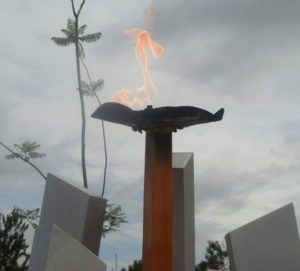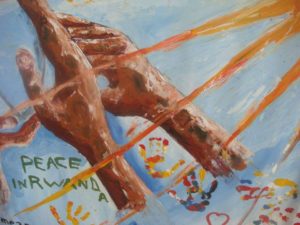Horrible histories

“The tragedy about history, personally and globally,
is that while we may see it, we rarely learn from it”
We travel for many reasons. Most move to escape, recharge or explore. There is that curiosity, to see the sights in a new place.
And there are many places developed for tourism, which contain horrible histories such as Auschwitz in Poland and the Tuol Sleng Museum in Cambodia. Do you ever wonder, why do we visit places with horrible histories, when we travel?
Almost ten years ago, friends visited us in Cape Town. They had their list of places that they wanted to see. And on that list was Robben Island.
The very thought of it took me back to my years of teenage activism; attending protests marches and candlelit vigils outside the South African Embassy, joining the movement to push for sanctions against the government during Apartheid, screaming at my mum for buying Cape grapes.
I had joined a campaign group in U.K and I read news coming from Robben Island. It was not a place that I had ever imagined I would visit. I had never wanted to go there.
But I was torn. These were good friends who had travelled all this way to see us. So I pushed my feelings to one side and we boarded the boat from Robben Island Gateway.
I said nothing as we walked around the prison cells. I took no photos. I did not need images to remember what I saw there. I knew this history.
I recall the first spot that reduced me to tears, standing out in the quarry. It was there that the inmates had been made to break stones for no reason, in the blinding light and blazing sun. So Inhumane. So cruel.
Robben Island is an important reminder of S.A’s horrible history. People should understand what happened during the struggle. But we will never go there again.
Have you ever felt like this, after visiting somewhere when travelling?
I felt a similar way on a trip to New York. The Twin Towers memorial was being built. The scene of the terrorist attack was a construction site. I watched as tourists took selfies and photos through the fencing. We crossed the street, looked briefly from a distance and remembered what happened that day.
Some years later, we travelled to Rwanda for the labour day long weekend. Four friends flew late on the Thursday, just over an hour’s journey from Nairobi. We did not expect what awaited there; the cleanest, greenest African capital we have ever visited. Everything worked well. The airport staff were efficient. Everyone was asked to donate their carrier bags at the airport, an effort to avoid polluting with plastic. Kigali was an impressive capital, a model city in many ways for others across the African continent. Many positives have emerged since a horrible history.
We stayed at an art gallery in a suburb, which had two air b n b guest rooms at the back. Our host was fantastic. He made so many efforts to make us welcome. He recommended good places to go. He proudly took us around the capital city.
We visited the Milles Collines hotel, the actual ‘Hotel Rwanda’ which the film is based on. It was here that the hotel staff had offered sanctuary to people from the militia during Rwanda’s genocide. The compassionate hotel manager, Paul Rusesabagina, was consulted during the production of the script. Parts of the film came back to me and I remembered some of the archive television footage. The film delivered an important account of what happened. And the producers of the film worked with the U.N to fundraise, going on to provide vital support to Rwandan survivors.
There was a small monument, acknowledging the role that the hotel played in saving many lives. But much of the film was shot in other parts of Kigali, as well as in Johannesburg.
The following day we spent time in local craft markets, art galleries and cafes. All of us were happy. The afternoon was a sobering contrast.
We drove to the site of the genocide memorial in Kigali. Two of our group opted not to go in. On this occasion I found myself wanting to go. I wanted to learn more and understand how this happened. I didn’t want to shy away, for fear of getting upset.
As I walked into the building, down a long staircase into the dark ‘museum-ness’ of up lit displays and projections, I instantly felt the heaviness of what was there. I meandered from one room to another, choosing to focus mainly on the visuals. I looked. I watched. Press images, footage, photographs. Carefully curated pieces documented this atrocity.
Images of the mass graves were beyond disturbing. One display featured the words
‘the country smelt of death
Rwanda was dead’
How did this happen?
I had watched a documentary about the memorial before, which had featured some of the exhibits like bones and other remains of the dead. As shocking as that was, I was expecting to see it. What I wasn’t prepared for was a room full of clothes hung from the ceiling, garments which represented so many who had been brutally slaughtered. In another room there were myriad photos of those lost to the genocide.
I sobbed. Uncontrollable tears of shock, despair, and anger. How did the world watch on while this took place? Why did it take so long for countries to intervene?
I knew it would be upsetting. It was harrowing.
So many people were killed, whole families were destroyed by human savagery and for what? I watched documentary films; testimonials by people who had lost their loved ones. One woman recalled how she had lost 41 members out of 50 in her family. How do you recover from that? A man spoke to camera and talked of the last meal that his mother ever prepared for him before she was murdered; a plate of simple, sliced passion fruit. He said that now, every time he sees those fruits, he immediately thinks of her.
Outside, in one part of the vast garden, an estimated 250,000 bodies are buried under concrete. People have laid flowers on the top of the grave, as they remember the dead.
The eternal flame, a universal symbol of peace reminded me of the one I had seen in Hiroshima, while working in Japan. Sadly people in the world continue to make the same mistakes. I thought to myself, I guess there will be more eternal flames.
What do we learn from visiting these places? What would political leaders learn from visiting these places? Might we ever learn from the mistakes from the past?
This month, on April 7th, it was the International Day of Reflection on the Genocide in Rwanda. Commemorations took place across the country to mark the 25th anniversary of the genocide. Rwanda will mourn for 100 days, signifying the time it took in 1994 for 800,000 Rwandans to be massacred.
Have you visited a site that tells the story of a country’s horrible history? What was your experience of visiting that place?

© Maggie M/Mother City Time
Your piece is bringing me back to our recent visit to Rwanda.. Kigali is such a green and clean city indeed.. Also the other cities we visited traveling 7 hours into the depth of the country to arrive to Nyamasheke on lake Kivu. Reading about your experience of the genocide memorial brought me back to that state of shivering insides while being there. I took with me so many stories and images of beautiful places and people.. they speak about forgiveness and I see they try. Yet, you see their eyes.. Before flying back to London, we spent our last night in Kigali in the Milles Collines hotel.. Rwanda is on my mind ..
I think that Rwanda will always be on our minds. We talk of it often. The genocide should never have happened. The world’s leaders should have done more to help. And even now more mistakes continue to be made. People deserve better. Thanks for reading, Irina